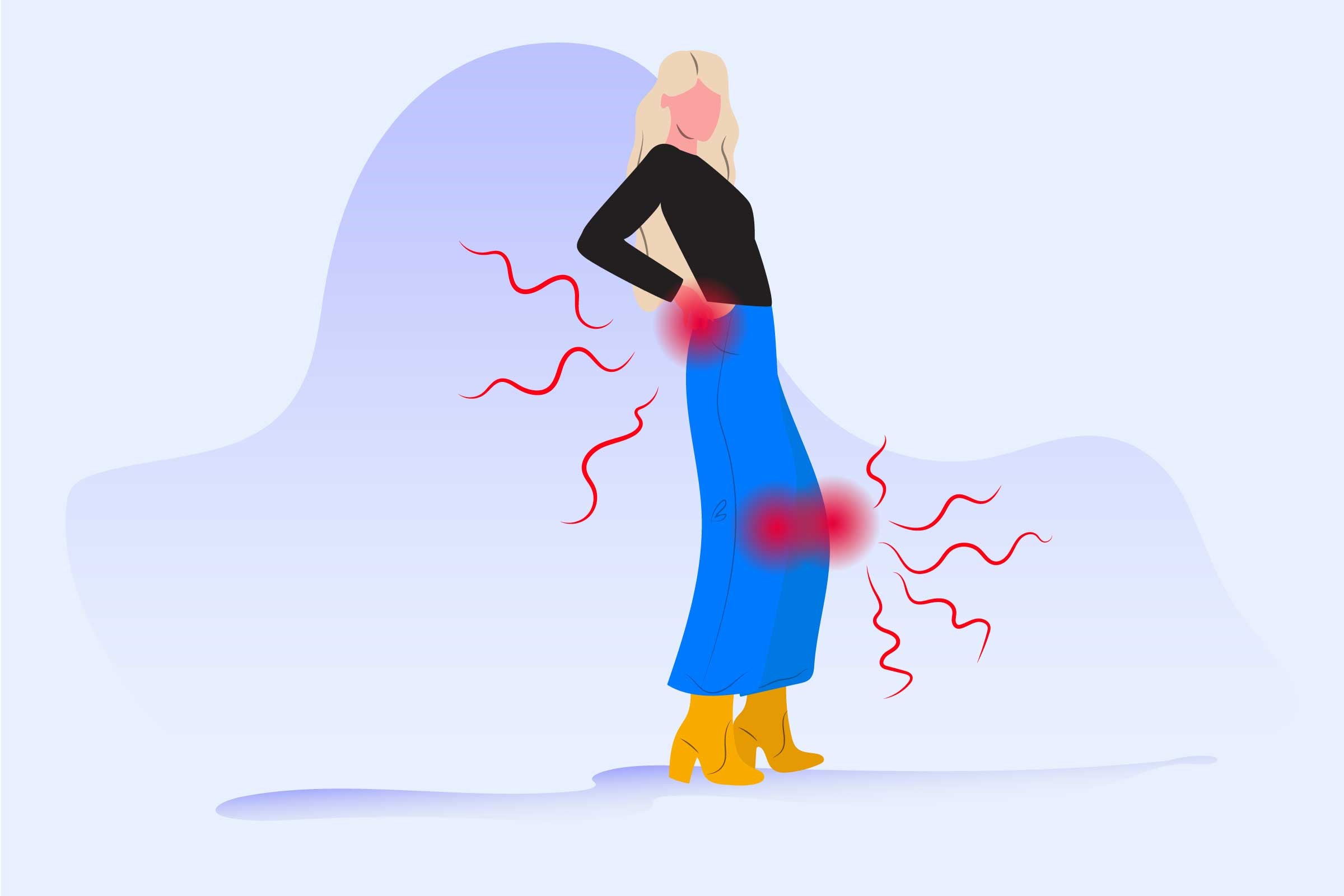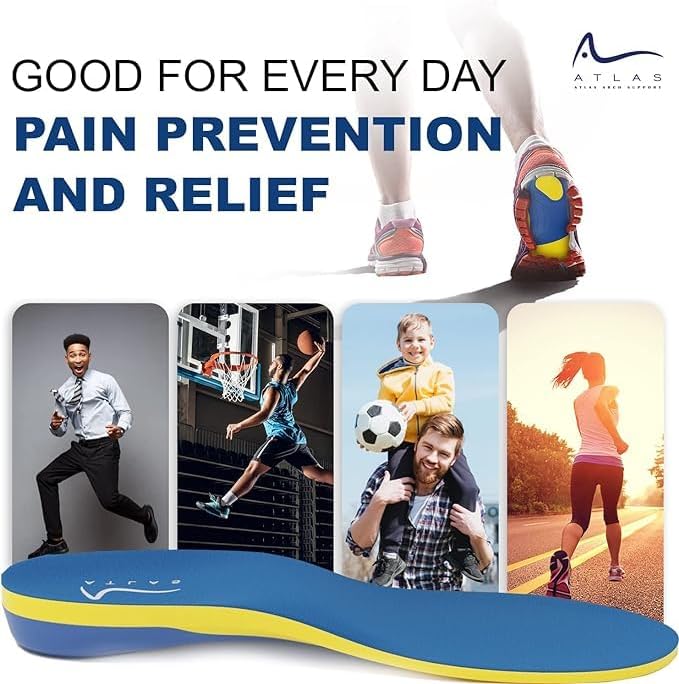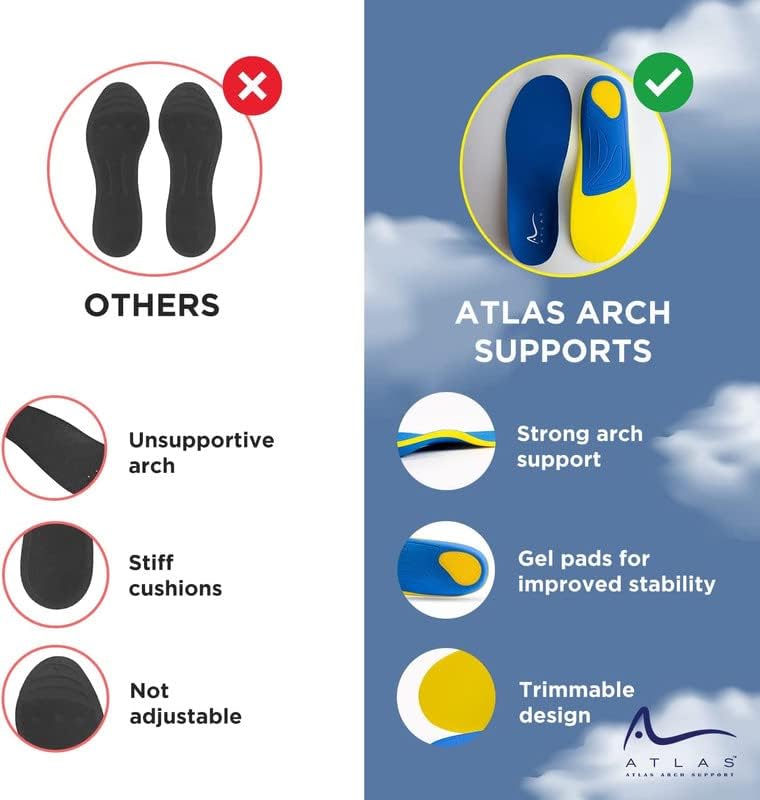Unlock the secret to alleviating back and knee pain with our guide on the best arch support insoles. Learn how proper foot alignment can transform your health and enhance your daily comfort.

Introduction
Welcome to our in-depth guide on arch support insoles, a crucial tool for anyone suffering from back and knee pain. With insights from leading foot specialists, we delve into how these insoles not only offer relief but also prevent discomfort by ensuring proper foot alignment. Whether you’re an athlete, someone with a demanding job, or just looking to improve your overall foot health, our guide will help you find the perfect insoles for your needs.
Table of Contents
Back Pain

Back pain is a common ailment affecting a large segment of the population at various times in their lives. It presents in many forms, from general discomfort in the lower back to sharp pains in the upper back and neck areas. Interestingly, even though back pain can often be traced back to issues with the feet, many people with back pain do not experience or report any foot pain. This situation underscores the intricate link between the alignment of our bodies and the pain we feel.
Exploring the Link Between Feet and Back Pain
The connection between foot issues and back pain usually comes down to asymmetry or misalignment starting from the feet, which are the foundation of our body’s structure. Misalignments, such as overpronation (excessive inward rolling of the feet) or underpronation (insufficient inward rolling), can lead to a chain reaction affecting the legs, hips, and lower back. This misalignment can strain the lower back muscles as they attempt to maintain posture, causing pain that may be felt up the spine.
Our feet are naturally designed to walk on soft, uneven ground, but modern life predominantly exposes us to hard, flat surfaces. This, combined with footwear that doesn’t support natural foot movements, significantly contributes to alignment issues that can manifest as back pain.
Identifying Symptoms of Back Pain
Symptoms of back pain can range widely but often include:
- Persistent aching or discomfort in the lower back.
- Pain that spreads to the upper back and neck.
It’s important to note that back pain sufferers might not always link their discomfort to foot pain, even if it originates there.
Root Causes of Back Pain Related to Foot Alignment
The main culprit behind back pain related to foot alignment is improper foot pronation, affecting the body’s skeletal alignment from the legs and hips up to the lower back. The hard, flat surfaces of today’s environments challenge the foot’s natural curvature, leading to alignment issues that put ongoing stress on the spine and result in back pain felt in various areas.
Approaches to Treating and Managing Back Pain
Addressing the root cause of back pain often means correcting the underlying misalignment. Effective strategies include:
Orthotics: Custom orthotics can significantly enhance posture and alignment, offering back pain relief with regular use. These devices aim to correct pronation issues, reducing strain on the back.
Footwear Modifications: Choosing shoes designed to support a natural walking motion or those with rocker bottom soles can help mimic the experience of walking barefoot on uneven terrain. This can improve alignment and lessen back pain. Ideally, these shoes should allow for orthotics to provide a customized solution to back pain management.
Lifestyle Changes: In addition to footwear adjustments and orthotics, adopting lifestyle changes like exercises that strengthen the core and improve posture can further help in alleviating back pain.
Knee Pain
Knee pain is a widespread issue that spans across all age groups, significantly hindering daily functions and an active way of life. Among the myriad causes of knee pain, the role of foot alignment in knee health is often underestimated. Recognizing how foot positioning affects the knees can pave the way for more targeted and effective interventions.

The Link Between Foot Alignment and Knee Pain
The alignment of our feet plays a crucial role in the health of our knee joints. Misalignments such as overpronation (too much inward rolling of the feet) or underpronation (not enough inward rolling) can impose abnormal stress on the knees. This stress forces the knees to adapt to the imbalance, potentially leading to discomfort and injury over time. Given that the feet are the base of our body’s structure, any misalignment can trigger a domino effect impacting the knees, hips, and lower back.
Identifying Knee Pain
The symptoms of knee pain can differ greatly but often encompass:
- Localized pain around the knee, intensifying with activities like walking, running, or ascending stairs.
- Swelling and stiffness in the knee.
- Audible popping or crunching sounds during movement.
- A sensation of weakness or instability in the knee, as though it might collapse.
It’s crucial to recognize that knee pain may stem from knee-specific issues or from underlying foot misalignments.
Foot Alignment and Its Impact on Knee Pain
Foot alignment influences knee pain primarily through how weight and pressure are distributed during movement. Incorrect alignment can cause an uneven force distribution, placing undue stress on parts of the knee, which over time leads to wear and tear. Key factors include:
- Overpronation: This condition can cause the knee to turn inward, stressing the joint.
- Underpronation: This can decrease shock absorption during movement, heightening the impact on the knees.
- Flat Feet or High Arches: Either condition can lead to improper weight distribution and alignment, affecting the knees.
Approaches to Treating and Managing Knee Pain
Addressing knee pain effectively often means tackling the underlying misalignment. Key strategies are:
Orthotic Devices: Both custom and store-bought orthotics can correct foot alignment, thus alleviating knee stress. These devices are essential for rectifying overpronation or underpronation.
Supportive Footwear: Choosing shoes with proper support and cushioning can maintain correct foot alignment and lessen knee impact. Selecting the right shoes is vital, considering the individual’s foot type and activities.
Physical Therapy: Tailored exercise programs focusing on strengthening knee-surrounding muscles and enhancing flexibility can stabilize the knee joint and improve alignment.
Lifestyle Adjustments: Limiting activities that aggravate knee pain, keeping a healthy weight, and engaging in low-impact exercises can aid in symptom management and prevent further damage.
Importance of Arch Support Shoe Insoles
1. Enhancing Foot Alignment
Support for Natural Arch: Arch support insoles play a pivotal role in upholding the foot’s natural arch, preventing its collapse during activities that bear weight. This is essential for maintaining correct foot alignment.
Even Pressure Distribution: These insoles ensure that the pressure exerted on the foot is distributed more uniformly, thereby minimizing stress concentration on specific areas like the heel or ball of the foot.
2. Mitigating Overpronation
Managing Excessive Inward Rolling: Overpronation, characterized by the foot rolling inward too much during movement, is mitigated by arch support insoles. This can substantially lessen the strain on the knees and lower back.
Correcting Alignment: By managing overpronation, these insoles aid in the proper alignment of the legs and feet, diminishing stress on the knee joints and lower back.

3. Boosting Shock Absorption
Enhanced Cushioning: Quality arch support insoles are designed with cushioning that absorbs the shock with each step, beneficial in reducing the impact on knees and back.
Protection from Hard Surfaces: The cushioning also shields the feet from hard surfaces, lessening the immediate impact and the subsequent strain on the back and knees.
4. Improving Biomechanics
Promoting Efficient Movement: Correct foot alignment and support from insoles enhance the biomechanics of walking or running, minimizing unnecessary strain on the musculoskeletal system, including the back and knees.
Energy Efficiency: Better biomechanics allow the body to use energy more effectively, decreasing fatigue and the likelihood of pain from overuse or incorrect foot mechanics.

5. Supporting Overall Posture
Enhancing Postural Stability: Foot alignment directly influences the body’s posture. Proper arch support from insoles can lead to improved overall posture, vital for alleviating back and knee pain.
Long-Term Postural Improvements: Regular use of arch support insoles can result in lasting enhancements in posture and alignment, potentially easing chronic back and knee pain conditions.
Evidence from Research on Arch Support Insoles
- A study by Smith et al. (2017) revealed that participants using arch support insoles reported a notable decrease in back and knee pain compared to those without insoles.
- Research by Johnson et al. (2019) indicated that arch support insoles were effective in improving pain scores and functional abilities in individuals suffering from chronic knee pain.
Frequently Asked Questions
Q: How do arch support insoles help alleviate back and knee pain?
A: By ensuring proper foot alignment, arch support insoles distribute weight evenly, reducing stress on the back and knees and mitigating pain.Q: Can anyone use arch support insoles? A: Yes, arch support insoles are beneficial for people of all ages and activity levels, especially those experiencing foot-related back and knee pain.Q: How often should I replace my arch support insoles? A: It’s recommended to replace your insoles every 6 to 12 months, depending on wear and tear, to maintain optimal support and hygiene.Q: Are custom orthotics better than over-the-counter arch support insoles? A: Custom orthotics offer personalized support but can be costly. Many find over-the-counter arch support insoles to be an effective and affordable alternative.
Conclusion
Arch support insoles are a game-changer for individuals suffering from back and knee pain due to foot misalignment. By choosing the right insoles, you can enjoy improved posture, enhanced comfort, and a significant reduction in pain. Embrace the journey towards a more comfortable and active lifestyle with the ideal arch support insoles tailored to your needs.










